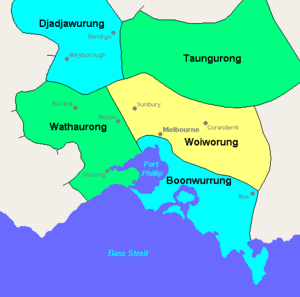Wadawurrung language facts for kids
Quick facts for kids Wathawurrung |
|
|---|---|
| Wathaurong | |
| Region | Victoria |
| Ethnicity | Wathaurong people |
| Language family | |
| AIATSIS | S29 |

The five Kulin nations. Wathawurrung ('Wathaurong') is in on the coast in green.
|
|
Wadawurrung, also known as Wathawurrung or Wathaurong, is an Aboriginal Australian language. It was spoken by the Wathaurong people. They are part of the Kulin Nation in Central Victoria.
The Wathaurong people lived south of the Werribee River. Their land stretched across the Bellarine Peninsula to Streatham. There were 15 different groups, or clans, who spoke this language.
Today, the Wathawurrung language is considered extinct by some. However, many groups are working hard to bring it back. They are teaching the language and promoting its use. This helps keep the culture and history alive.
Words and Places
The Wathawurrung language has given names to many places. These names often describe the land or animals found there. Learning these names helps us understand the history of the area.
Place Names and Their Meanings
Here are some local place names. They come from the Wathawurrung language. Each name has a special meaning.
| Place Name | Meaning |
|---|---|
| Barrabool | This name has a few possible meanings. It could mean "oyster," "slope down to water," or "rounded hill." |
| Barwon | This comes from Barrwang, meaning "Magpie." The town of Parwan has the same origin. |
| Bungaree | This word means "hut" or "tent." |
| Buninyong | From Buninyouang. Early settlers said it meant "Man lying on back with raised knee." This describes the shape of Mount Buninyong. |
| Connewarre | From koonoowarra, meaning black swan. The town of Koonwarra also shares this origin. |
| Corio | Possibly "Sandy cliffs." Other ideas are "small marsupial" or "wallaby." Some think it was the original name for Corio Bay. |
| Geelong | From Djillong. The City of Greater Geelong says it means "Land" or "Cliffs." Others suggest it was the first name for Corio Bay. |
| Gheringhap | This might come from "gheran" meaning "timber." Or it could refer to the black wattle tree. |
| Gnarwarre | Named after a local wetland and its birds. It might be related to Lake Connewarre and kunuwarra (black swan). |
| Jan Juc | This name means either "milk" or "ironbark." |
| Koorweinguboora | This means either "where the crane eats frogs" or "land of many waters." |
| Modewarre | This name refers to the musk duck. |
| Moolap | This was a meeting place. People gathered shellfish here. |
| Moorabool | This could be from a word for "ghost" or the name for the curlew bird. |
| Moriac | This word simply means "hill." |
| Myrniong | This is the name of the native yam-daisy plant. It is also spelled Murnong. |
| Parwan | From Barrwang, meaning "Magpie." This is the same origin as the Barwon River. |
| Wendouree | From wendaaree, which means "go away" in Wathawurrung. A story says that when a settler asked a local woman the name of the lake, she told him to go away. |
| Werribee | From Wirribi-yaluk, the name of the Werribee River. Wirribi is said to mean "spine" or "backbone." |
| Wingeel | This comes from the word for the wedge-tailed eagle. This eagle is also a creator spirit in their stories. |
| Woady Yaloak River | From Wurdi-yaluk, meaning "big creek." |
| You Yangs | Reportedly Ude Youang, meaning "big mountains." |
Animal Names
The Wathawurrung language also has many names for local animals.
- 'Djirnap' - Cockatoo
- 'Goim', 'Kuyim' - Kangaroo
- 'Ngurr-ngurr' - Wombat, likely the Common Wombat
- 'Ngambulmum' - Koala, which means 'bottom of a tree fork'
- 'Mon.garrk', 'Mon.ngarrk' - Echidna
- 'Perridak' - Platypus
- 'Walart' - Possum. The term 'Walart-walart' means a possum skin cloak. 'Barnong' is another word for the Ringtail Possum.
See also

- In Spanish: Idioma wathaurong para niños

